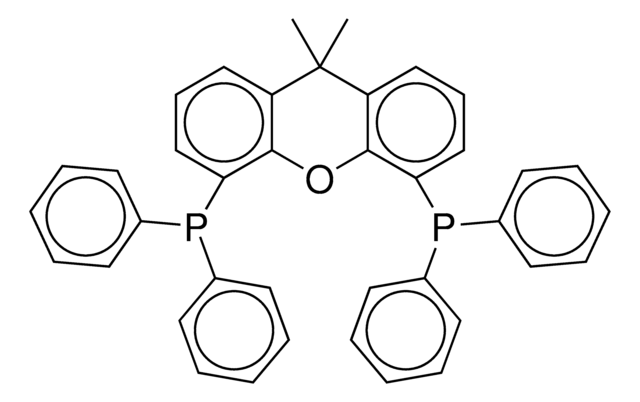932213
XantPhos Pd G3 ChemBeads
Synonym(s):
[(4,5-Bis(diphenylphosphino)-9,9-dimethylxanthene)-2-(2′-amino-1,1′-biphenyl)]palladium(II) methanesulfonate
Sign Into View Organizational & Contract Pricing
All Photos(1)
About This Item
Empirical Formula (Hill Notation):
C52H45NO4P2PdS
CAS Number:
Molecular Weight:
948.35
UNSPSC Code:
12352101
NACRES:
NA.22
Recommended Products
General description
XantPhos Pd G3 is a third generation (G3) Buchwald precatalyst. It is air, moisture and thermally-stable and is highly soluble in a wide range of common organic solvents. It has long life in solutions. XantPhos Pd G3 is an excellent reagent for palladium catalyzed cross-coupling reactions. Some of its unique features include lower catalyst loadings, shorter reaction time, efficient formation of the active catalytic species and accurate control of ligand: palladium ratio.
Application
XantPhos Pd G3 may be used in the following processes:
Negishi cross-coupling reaction during the synthesis of palmerolides.
Aminocarbonylation of heteroaryl bromides with carbon monoxide (CO) in the presence of triethylamine.
Coupling between polyglycosyl thiols and aglycon halides by C-S bond formation.
ChemBeads are chemical coated glass beads. ChemBeads offer improved flowability and chemical uniformity perfect for automated solid dispensing and high-throughput experimentation. The method of creating ChemBeads uses no other chemicals or surfactants allowing the user to accurately dispense sub-milligram amounts of chemical.
Learn more about ChemBeads products
Product is also available as neat precatalyst (763039)
Negishi cross-coupling reaction during the synthesis of palmerolides.
Aminocarbonylation of heteroaryl bromides with carbon monoxide (CO) in the presence of triethylamine.
Coupling between polyglycosyl thiols and aglycon halides by C-S bond formation.
ChemBeads are chemical coated glass beads. ChemBeads offer improved flowability and chemical uniformity perfect for automated solid dispensing and high-throughput experimentation. The method of creating ChemBeads uses no other chemicals or surfactants allowing the user to accurately dispense sub-milligram amounts of chemical.
Learn more about ChemBeads products
Product is also available as neat precatalyst (763039)
Other Notes
High-Throughput Reaction Screening with Nanomoles of Solid Reagents Coated on Glass Beads
Versatile Methods to Dispense Sub-Milligram Quantities of Solids using Chemical Coated Beads for High-Throughput Experimentation
ChemBead Enabled High-Throughput Cross-Electrophile Coupling Reveals a New Complementary Ligand
Versatile Methods to Dispense Sub-Milligram Quantities of Solids using Chemical Coated Beads for High-Throughput Experimentation
ChemBead Enabled High-Throughput Cross-Electrophile Coupling Reveals a New Complementary Ligand
related product
Product No.
Description
Pricing
Storage Class Code
11 - Combustible Solids
WGK
WGK 3
Flash Point(F)
Not applicable
Flash Point(C)
Not applicable
Choose from one of the most recent versions:
Certificates of Analysis (COA)
Lot/Batch Number
Sorry, we don't have COAs for this product available online at this time.
If you need assistance, please contact Customer Support.
Already Own This Product?
Find documentation for the products that you have recently purchased in the Document Library.
Versatile Methods to Dispense Submilligram Quantities of Solids Using Chemical-Coated Beads for High-Throughput Experimentation
Martin, et al
Organic Process Research & Development, 23, 1900?1907-1900?1907 (2019)
High-Throughput Reaction Screening with Nanomoles of Solid Reagents Coated on Glass Beads
Tu, Noah P., et al.
Angewandte Chemie (International Edition in English), 58, 7987-7991 (2019)
Ana L Aguirre et al.
Chemistry (Weinheim an der Bergstrasse, Germany), 27(51), 12981-12986 (2021-07-08)
High-throughput experimentation (HTE) methods are central to modern medicinal chemistry. While many HTE approaches to C-N and Csp2 -Csp2 bonds are available, options for Csp2 -Csp3 bonds are limited. We report here how the adaptation of nickel-catalyzed cross-electrophile coupling of
Our team of scientists has experience in all areas of research including Life Science, Material Science, Chemical Synthesis, Chromatography, Analytical and many others.
Contact Technical Service








